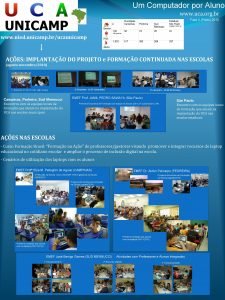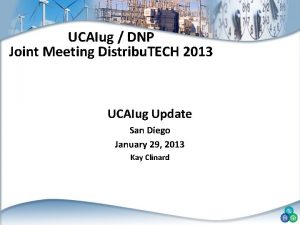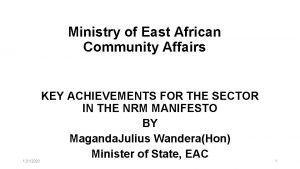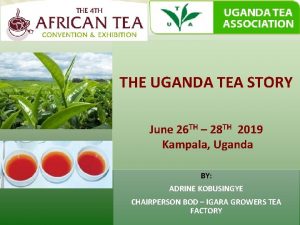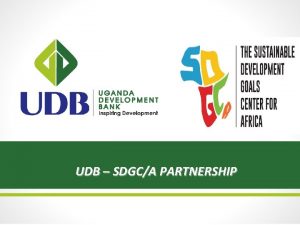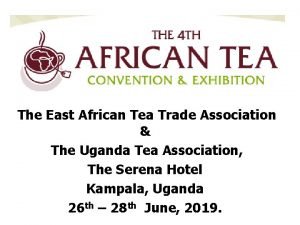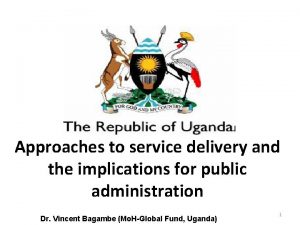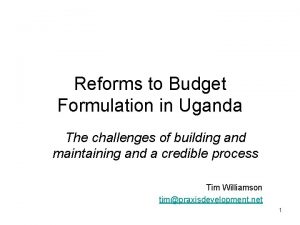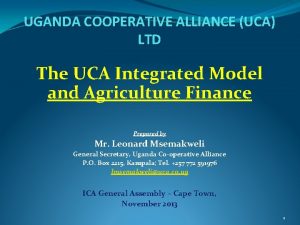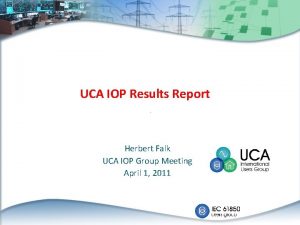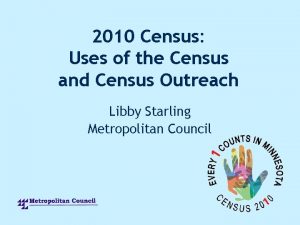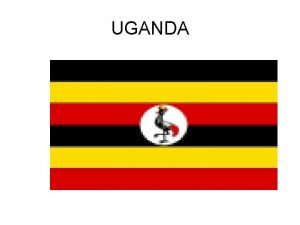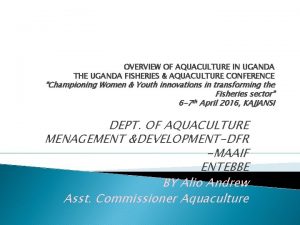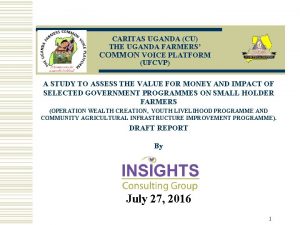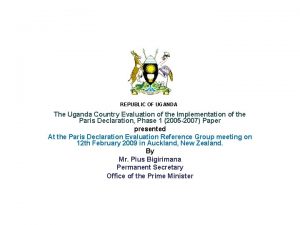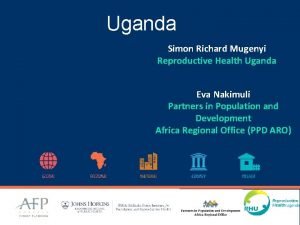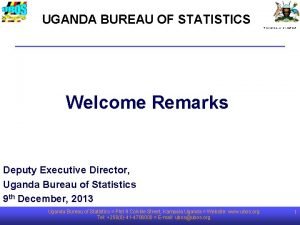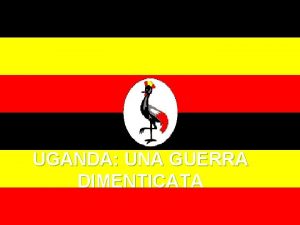THE UGANDA CENSUS OF AGRICULTURE UCA 200809 Presented
















- Slides: 16

THE UGANDA CENSUS OF AGRICULTURE (UCA) 2008/09 Presented at the 21 st Session of the African Commission on Agricultural Statistics , Accra, Ghana, October 28 -31, 2009 By Seth N. Mayinza Director, UCA 1

Outline of Presentation l l l l l 2 Introduction and Background Agriculture in the Ugandan Economy Past Censes of Agriculture The UCA 2008/09 Coverage of the UCA Arrangements to Conduct the UCA The UCA Budget Progress Made to Conduct the UCA On-going Activities Challenges

Introduction and Background l Ø Ø 3 Uganda is a land-locked country in East Africa with a total surface area of 241, 550. 7 square kilometres (sq. km) of which 199, 807. 4 sq km is land 41, 743. 2 sq km are open water and swamps, The altitude above sea level ranges from 620 metres to 5, 111 metres Temperatures range from 15 to 31 degrees celsius Rainfall is between 735 to 1863 millimetres per year.

Introduction and Background Cont’d l 4 The total population of the country is 30. 7 million (2009 mid-year estimate based on the 2002 Population and Housing Census). The next Population and Housing Census (PHC) is slated for 2012.

Agriculture in the Ugandan Economy 5 l Agriculture is the dominant sector of Uganda’s economy. l This sector contributes about 21. 5% to total Gross Domestic Product (GDP) and over 90% to total export earnings. It provides 80% of employment and most industries and services in the country are based on this sector. About 85% of the population live in rural areas of the country where they derive their livelihood from agriculture. l Much of the agricultural production in Uganda takes place at household level essentially using household labour. Currently, there about 4. 2 million holders who carry rain-fed agriculture and who on the average cultivate less than 2. 0 hectares mainly using hand-hoes, pangas and ploughs. It has been estimated that 80 percent and 60 percent of women and men respectively are employed in agriculture as their main activity.

Past Censuses of Agriculture in Uganda l l 6 First Census of Agriculture: 1963/65; Go. U was assisted by FAO and UK financially and technically; Second Census of Agriculture called the National Census of Agriculture and Livestock (NCAL): 1990/91; Funded by the UNDP and executed by FAO.

The UCA 2008/9 l l 7 During FY 2007/08, Go. U availed UGX 5. 8 billion for the UCA 2008/09. FY 2007/8 was preparatory and actual data collection is in 2008/9 Agricultural Year (second season of 2008 and first season of 2009). The UCA 2008/9 is mainly crop census The Ministry of Agriculture in collaboration with UBOS conducted a livestock census in February 2008 where detailed data on livestock was collected. Few variables on livestock are therefore being collected in the UCA 2008/9 to provide a linkage between the two censuses

Coverage of the UCA l Ø Ø Ø 8 The UCA 2008/09 is collecting information on 6 modules: 1. Listing Module 2. Agricultural Household and Holding Module 3. Community Module 4. Crop Area Module 5. Crop Production Module 6. Private Large Scale and Institutional Farms (PLS&IFs)

Arrangements Made to Conduct the UCA, 2008/09 1) 2) 3) 4) 5) 9 Agric Module in the PHC 2002 Pilot Census of Agriculture (PCA) 2003 conducted in 10 Districts UCA Project document was prepared and finalized. Pre-test Conducted in Mityana in May-June 2008 UCA budget was prepared and finalized (a summary provided on next slide).

A Summary of the UCA Budget (UGX) (Exchange Rate I US $ = 1, 700 UGX) YEAR 2007/08 2008/09 2009/10 2010/2011/12 TOTAL Budget (Bill. )required for the UCA 5. 656 5. 800 2. 378 1. 673 0. 089 15. 598 Amount (Bill. ) committed by Government 5. 800 2. 400 0. 000 14. 000 0. 144(+) 0. 000 0. 022(+) 1. 673 (-) 0. 089 (-) Funding (Bill. ) Gap (-) /Surplus(+) 10 1. 762 (-)

Progress Made in Conducting the UCA 2008/09 1) 2) 3) 4) 5) 6) 11 7) Engagement of International consultants Design of UCA instruments. Procurement of Census items/goods. Sampling of EAs (3, 607). Identification of District Supervisors. Recruitment of Enumerators Training of UCA field staff.

Progress Made (Cont’d) 9) 10) 11) 12) 13) 14) 12 Distribution of listing forms October 2008 Listing commenced thereafter Recruitment of Headquarter staff, among whom were 12 Statisticians Training of the new Statisticians Draft Tabulation Plan received Editing rules developed.

Progress Made (Cont’d) 15) 16) 17) 18) 19) 13 Listing in the selected EAs and sampling. Official launching of the UCA, on November 18, 2008 at Kyanamukaka, Masaka by the Right Honourable Speaker of Parliament Administering Forms 4 and 5, for the second season of 2008 Recruitment and Training of Data Entry Operators Administering Form 4 for the first season of 2009

On-going Activities: 1) 2) 14 Administering Forms 5 for the first season of 2009, and Forms 2, and 6. Data Entry for the Completed Forms

Challenges in Conducting the UCA l l l l l 15 District Supervisors have other responsibilities/programs Delayed release of funds to supervisors and enumerators Difficulties with some maps Concept of household not well understood by some enumerators (use household and homestead interchangeably Sampled EAs with holdings but without households High Attrition rate among enumerators, which brings the challenges of training new ones and of updating the accounts database Insecurity in some areas of the country Long distances between EAs covered by some enumerators Poor Roads

END OF PRESENTATION Thank you! 16
 Www.uca
Www.uca Nota de corte ade granada
Nota de corte ade granada Uca dnp program
Uca dnp program Torreyson apartments uca
Torreyson apartments uca Inscription administrative uca
Inscription administrative uca Uca college of business
Uca college of business Uca prepaid training
Uca prepaid training Uca soft skills
Uca soft skills Bernard hall uca
Bernard hall uca Uca academic probation
Uca academic probation Ministry of east african community affairs uganda
Ministry of east african community affairs uganda Tea growing in uganda
Tea growing in uganda Sdgca
Sdgca African tea uganda
African tea uganda Uganda aids rate
Uganda aids rate Marine insurance act uganda
Marine insurance act uganda Challenges of budget implementation in uganda
Challenges of budget implementation in uganda
